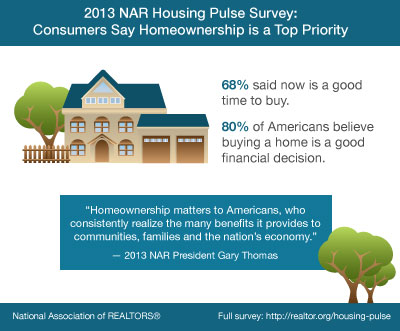Concerns of the depleting and then crashing economy in 2010-2011 (some areas saw this years prior) caused many consumers to shy away from getting a piece of the American dream. As banks foreclosed on homes, more and more people became renters as a temporary alternative to owning a home.
Recently, the market has been on the rise, and housing specifically seems to be picking up. A recent survey was conducted by the National Association of REALTORS that showed a concise agreement that consumers view homeownership a top priority as compared to previous years.
Americans overwhelmingly believe owning a home is a good financial decision and a majority of renters say homeownership is one of their highest priorities for the future. The 2013 National Housing Pulse Survey also found that renters are thinking more about purchasing a home now than in past years, while the number of people who say they prefer to rent has declined.

Some key findings from the year’s survey include:
- Eight-in-ten Americans believe buying a home is a good financial decision, up 8 points since 2011.
- Half of renters now say that eventually owning a home is one of their highest personal priorities, up 9 points from 2011.
- Respondents expect to see continued improvement, as 37 percent expect real estate sales to increase in the year ahead.
Source: http://www.realtor.org/reports/housing-pulse-surveys